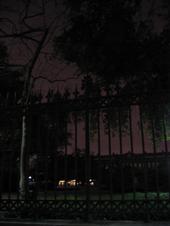Ballroom Dance is Dead was started in the fall of 2006 by New Orleans producer and bassist Grant W. Curry (Pleasure Club, PW Long) and Brooklyn-based guitarist/composer Lynn Wright (Bee & Flower, GachupÃn, Lepers of Melancholy) to explore the collision of Eno-inspired minimalism, trance, and the spirit of Sonny Sharrock. The first in a projected series of recordings with a revolving-door cast of drummers and horn players, this eponymous offering (released January 2008) is a collaboration with Drums & Tuba drummer Tony Nozero, featuring percussionist Mike Dillon (Critters Buggin’, Les Claypool, Garage a Trois).
------------------------------------------------------------
-----------------
Delusions of Adequacy, Jon Gordon, October 2008
Memo to anyone who automatically namechecks Brian Eno whenever describing anything as either 'ambient' or 'esoteric': name two other members of Roxy Music, something I am certain Grant Curry could. I am also certain that the band which performs the five instrumental tracks which make up Ballroom Dance Is Dead could also do this, as well as namechecking a plethora of other influences ranging from Lee Perry to Holger Czukay, in between necking bourbon alongside Tom Waits and throwing together whatever free jazz improvisations the maximum number of available musicians can muster between them. And if there's a tinge of sorrow around the tracks on Ballroom Dance Is Dead then is that perhaps down to the fact that New Orleans native Curry's favourite bar and probably his vinyl collection went under during the floods that gripped the Louisiana coast not so very long ago?
This is hypothesising on my part. Certainly there's a sombre tone around Ballroom Dance Is Dead and the sleeve artwork has a morbid look to it which doesn't quite capture the depth or timbre of the music. The five tracks on BDID are a collection of mostly drum and bass workouts around which are woven sequences of reverberating guitar and percussion. Specifically, the tracks are built around Grant Currys solid basslines, which rely on repetition and lowering the scale of the instrument until it is almost percussive. Ballroom Dance Is Dead is in fact a dub album, in the traditional sense of the phrase, and there are some quite obvious pointers as to where Curry and his associates take their cues from, assuming that you the listener are quite familiar with the styling - late 70s/early 80s reggae/jazzfunk/experimentalism but moving as far as possible away from the now overworked Talking Heads blueprints and aiming at an altogether less abrasive, more solid and weightier sound.
"Carnival Dirge" for example, starts off sounding as if it owes something to Mezzanine era Massive Attack then takes on a swirling atmospheric quality that puts any instant comparisons subtly but firmly into their place. The entire mood and texture is late night, subdued, decidedly downbeat, but the combination of methodical rhythmic structure and layered keyboard effects make for an edgy slice of noir-ish easy listening. Meanwhile, the jittering guitars of "Elysium" add an abstracted nervous energy to the brush drummed backstrokes and bass chords: what you won't hear are throwaway electronic trickery or overworked retro type keyboard noises.
The final track leads us quite definitely into jazz territories. "India" is an interpretation of a John Coltrane original and this works, as does the album as a whole, mostly because of the resolutely simplistic bass style which relies on overwhelming the amps rather than baffling us with speed and accuracy, and the whole thing starts to resemble PIL so much that I half expected the cracked-tooth yelp of John Lydon to make a sudden guest appearance.
Ballroom Dance Is Dead is, I hope, only the beginning of this particular project from some highly experienced and committed sounding musicians whose motives are obscure but whose results make for a fascinating listen. There's definitely something alive down there.
------------------------------------------------------------
-----
Sea of Tranquility, Ryan Sparks, November 2008
...they turn in an absolutely brilliant run through of John Coltrane's "India". While they do keep much of the basic melody of the original intact, as well as the main opening and closing themes, everything else in between is a veritable free for all, especially as far as Wright is concerned. Mike Dillon's exotic percussion on tabla coupled with Nozero's delicate and articulate drumming propel the rhythm's along as this track swells to almost thirteen minutes in length. Wright appears and reappears throughout, each time upping the ante with one searing, abstract solo after another. This track should definitely command your attention for its full duration.
------------------------------------------------------------
-----
One True Dead Angel, September 2008
Eerie, tranced-out music that's more than worth hearing.
------------------------------------------------------------
----
Hoodoo Music Blog, Chris Becker, August 2009
This isn't babies and Starbucks. This is trance music that is rich and evocative in its layered instrumental colors; a very fluid and dub-like approach to what could be a hoary musical genre. This is instrumental music infused with the spirit of experimental, forward-thinking rock without the pretense, the goblins, and the leagues of crafty musos. This isn't musical wallpaper. If PIL jammed with Big Fun era Miles Davis in a haunted house in New Orleans' Garden District, the results might be similar.
